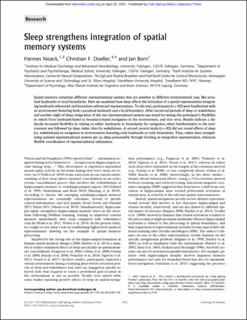| dc.contributor.author | Noack, Hannes | |
| dc.contributor.author | Doeller, Christian Fritz Andreas | |
| dc.contributor.author | Born, Jan | |
| dc.date.accessioned | 2021-12-14T09:25:23Z | |
| dc.date.available | 2021-12-14T09:25:23Z | |
| dc.date.created | 2021-08-18T13:34:18Z | |
| dc.date.issued | 2021 | |
| dc.identifier.citation | Learning & memory (Cold Spring Harbor, N.Y.). 2021, 28 (5), 162-170. | en_US |
| dc.identifier.issn | 1072-0502 | |
| dc.identifier.uri | https://hdl.handle.net/11250/2834119 | |
| dc.description.abstract | Spatial memory comprises different representational systems that are sensitive to different environmental cues, like proximal landmarks or local boundaries. Here we examined how sleep affects the formation of a spatial representation integrating landmark-referenced and boundary-referenced representations. To this end, participants (n = 42) were familiarized with an environment featuring both a proximal landmark and a local boundary. After nocturnal periods of sleep or wakefulness and another night of sleep, integration of the two representational systems was tested by testing the participant's flexibility to switch from landmark-based to boundary-based navigation in the environment, and vice versa. Results indicate a distinctly increased flexibility in relying on either landmarks or boundaries for navigation, when familiarization to the environment was followed by sleep rather than by wakefulness. A second control study (n = 45) did not reveal effects of sleep (vs. wakefulness) on navigation in environments featuring only landmarks or only boundaries. Thus, rather than strengthening isolated representational systems per se, sleep presumably through forming an integrative representation, enhances flexible coordination of representational subsystems. | en_US |
| dc.language.iso | eng | en_US |
| dc.publisher | Cold Spring Harbor Laboratory Press | en_US |
| dc.rights | Navngivelse-Ikkekommersiell 4.0 Internasjonal | * |
| dc.rights.uri | http://creativecommons.org/licenses/by-nc/4.0/deed.no | * |
| dc.title | Sleep strengthens integration of spatial memory systems | en_US |
| dc.type | Peer reviewed | en_US |
| dc.type | Journal article | en_US |
| dc.description.version | publishedVersion | en_US |
| dc.rights.holder | Locked until 15.4.2022 due to copyright restrictions. This article is distributed exclusively by Cold Spring Harbor Laboratory Press for the first 12 months after the full-issue publication date (see http://learnmem.cshlp.org/site/misc/terms.xhtml). After 12 months, it is available under a Creative Commons License (Attribution-NonCommercial 4.0 International), as described at http://creativecommons.org/licenses/by-nc/4.0/. | en_US |
| dc.source.pagenumber | 162-170 | en_US |
| dc.source.volume | 28 | en_US |
| dc.source.journal | Learning & memory (Cold Spring Harbor, N.Y.) | en_US |
| dc.source.issue | 5 | en_US |
| dc.identifier.doi | 10.1101/LM.053249.120 | |
| dc.identifier.cristin | 1926966 | |
| cristin.ispublished | true | |
| cristin.fulltext | preprint | |
| cristin.qualitycode | 2 | |

